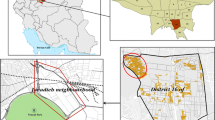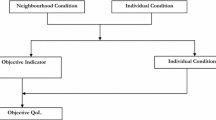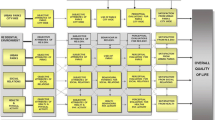Abstract
Quality of urban life (QOUL) has become an important field within urban studies. The increased level of attention to this topic is due to the increasing importance of QoL studies in monitoring public policies and in the role they can play as effective tools in urban management and planning. The main objective of this study is to measure the QOUL in the town of Noorabad in Iran, using subjective and objective indicators. In addition to secondary datasets, this study relies on a perception survey of households in the selected city. Based on an 11-point Likert scale, the mean of the overall life satisfaction of the respondents was found to be 6.06. At the same time, it has been found that satisfaction from employment opportunities is lowest among all other indicators. The comparison between the subjective and objective QoL in Noorabad indicated that 25 % of the households are in a state of well-being, 30.1 % are in a state of deprivation, while 24.4 % are in dissonance and 20.4 % are in a state of adaptation. Although correlation between objective and subjective dimensions of the QoL has not been found to be high, in general, the findings of this study reveal the importance of simultaneous studying of both objective and subjective dimensions of QoL. Results and findings of this study will be useful in designing and implementing future policies in the town of Noorabad.


Similar content being viewed by others
Notes
\( n = {{\frac{{t^{2} pq}}{{d^{2} }}} \mathord{\left/ {\vphantom {{\frac{{t^{2} pq}}{{d^{2} }}} {1 + \frac{1}{N}\left( {\frac{{t^{2} pq}}{{d^{2} }} - 1} \right)}}} \right. \kern-\nulldelimiterspace} {1 + \frac{1}{N}\left( {\frac{{t^{2} pq}}{{d^{2} }} - 1} \right)}}. \)
References
Camagni, R., Capello, R., & Nijkamp, P. (1998). Towards sustainable city policy: An economy environment technology nexus. Ecological Economics, 24, 103–118.
Chen, Z., & Davey, G. (2008). Subjective quality of life in Zhuhai City, South China: A public survey using the international wellbeing index. Social Indicator Research, 91, 243–258.
Cummins, R. (1997). The comprehensive quality of life scale: Intellectual disability. (5th ed). Toorak: Deakin University School of Psychology.
Das, D. (2008). Urban quality of life: A case study of Guwahati. Social Indicators Research, 88, 297–310.
Dunning, H., Williams, A., Abonyi, S., & Crooks, V. (2008). A mixed method approach to quality of life research: A case study approach. Social Indicator Research, 85, 145–158.
Epley, D. R., & Menon, M. (2008). A method of assembling cross-sectional indicators into a community quality of life. Social Indicators Research, 88, 281–296.
Grasso, M., & Canova, L. (2008). An assessment of the quality of life in the European Union based on the social indicators approach. Social Indicator Research, 87, 1–25.
Hardi, P., & Pinter, L. (2006). City of Winnipeg quality of life indicators. In M. J. Sirgy, D. Rahtz, & D. Swain (Eds.), Community quality of life indicators: Best cases 2 (pp. 127–176). Berlin: Springer.
Ibrahim, M., & Chung, W. (2003). Quality of life of residents living near industrial estates in Singapore. Social Indicators Research, 61, 203–225.
Iran Statistics Center. (2006). Year book selected data. Accessed online at www.sci.org.ir/portal/faces/public/sci_en.
Johansson, S. (2002). Conceptualizing and measuring quality of life for national policy. Social Indicators Research, 58, 13–32.
Kamp, I. K., Leidelmeijer, K., Marsman, G., & de Hollander, A. (2003). Urban environmental quality and human well-being: Towards a conceptual framework and demarcation of concepts; a literature study. Landscape and Urban Planning, 65(1–2), 5–18.
Lee, Y. J. (2008). Subjective quality of life measurement in Taipei. Building and Environment, 43(7), 1205–1215.
Li, G., & Weng, Q. (2007). Measuring the quality of life in city of Indianapolis by integration of remote sensing and census data. International Journal of Remote Sensing, 28(2), 249–267.
Liu, B. C. (1976). Quality of life indicators in U.S. metropolitan areas. New York: Prager Publishers.
Marans, R. W., & Stimson, R. (2011). Investigating quality of urban life: Theory, methods, and empirical research. Social Indicators Research Series, 45, 1–29.
McCrea, R., Shyy, T. K., & Stimson, R. (2006). What is the strength of the link between objective and subjective indicators of urban quality of life? Applied Research in Quality of Life, 1(1), 79–96.
Modarres, A. (2006). Urbanization and the revolution: An introduction to the special issue. Cities, 23(6), 405–406.
Mulligan, G., Carruthers, J., & Cahill, M. (2004). Urban quality of life and public policy: A survey. In R. Capello & P. Nijkamp (Eds.), Advances in urban economics (pp. 729–802). Amsterdam: Elsevier Science B.
Noll, H. -H. (2000). Social indicators and social reporting: the international experience. http://www.ccsd.ca/noll1.html. Accessed 17 Sep 2001.
Pacione, M. (2003). Urban environmental quality and human well-being: A social geographical perspective. Landscape and Urban Planning, 65(1–2), 19–30.
Rapley, M. (2003). Quality of life research: A critical introduction. London: Sage.
Rezvani, M. R., & Mansourian, H. (2011). Developing small cities by promoting village to town and its effects on quality of life for the local residents. Social Indicators Research. doi:10.1007/s11205-011-9921-7.
Rinner, C. (2007). A geographic visualization approach to multi-criteria evaluation of urban quality of life. International Journal Geographic Information Science, 21(8), 907–919.
Rossouw, S., & Naude, W. (2008). The non-economic quality of life on a sub-national level in South Africa. Social Indicators Research, 86, 433–452.
Santos, L., & Martins, I. (2007). Monitoring urban quality of life: The Porto experience. Social Indicators Research, 80, 411–425.
Seik, F. T. (2001). Quality of life in cities. Cities, 18(1), 1–2.
Shafer, C. S., Koo Lee, B., & Turner, S. (2000). A tale of three greenway trails: User perceptions related to quality of life. Landscape and Urban Planning, 49, 163–178.
Talen, E., & Shah, S. (2007). Neighborhood evaluation using GIS: An exploratory study. Environment and Behavior, 39, 583–615.
Tesfazghi, E. S., Martinez, J. J., & Verplanke, J. J. (2009). Urban quality of life and its spatial distribution in Addis Ababa: Kirkos sub-city. Thesis for degree of Master of Science in Geo-information Science and Earth Observation, Specialisation: (Urban Planning and Management), Enschde, The Netherlands.
United Nations Population fund. (2007). State of world population 2007, unleashing the potential of urban growth. New York: UNFPA.
Wish, B. N. (1986). Are we really measuring the quality of life? Well-being has subjective dimensions, as well as objective ones. American Journal of Economics and Sociology, 43, 93–99.
Zapf, W. (1984). Individuelle Wohlfahrt: Lebensbedingungen und wahrgenommene Lebensqualität [Individual welfare: Living conditions and noticed quality of life]. In W. Glatzer & W. Zapaf (Eds.), Lebensqualita¨t in der Bundesrepublik. Objektive Lebensbedingungen und subjektives Wohlempfinden (pp. 13–26). Campus: Frankfurt am Main.
Zebardast, E. (2009). The housing domain of quality of life and life satisfaction in the spontaneous settlements on the Tehran metropolitan fringe. Social Indicators Research, 90, 307–324.
Author information
Authors and Affiliations
Corresponding author
Rights and permissions
About this article
Cite this article
Rezvani, M.R., Mansourian, H. & Sattari, M.H. Evaluating Quality of Life in Urban Areas (Case Study: Noorabad City, Iran). Soc Indic Res 112, 203–220 (2013). https://doi.org/10.1007/s11205-012-0048-2
Accepted:
Published:
Issue Date:
DOI: https://doi.org/10.1007/s11205-012-0048-2




